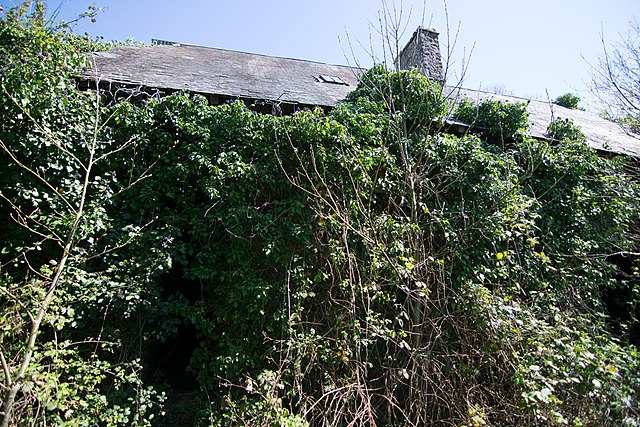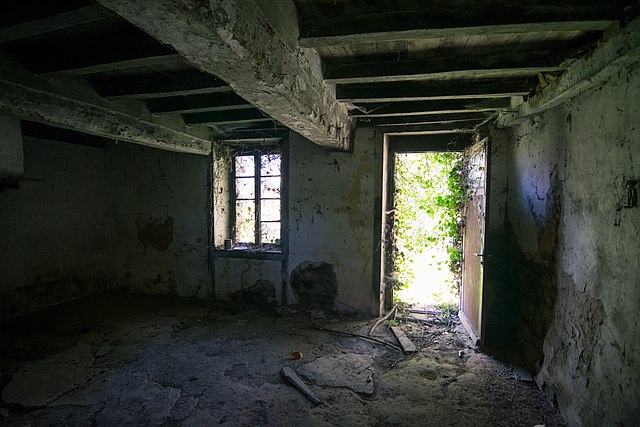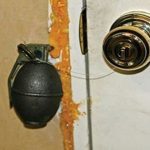 Mysteries
Mysteries  Mysteries
Mysteries  History
History 10 Surprising Stories About the Texas Rangers
 Humans
Humans 10 Philosophers Who Were Driven Mad by Their Own Theories
 Miscellaneous
Miscellaneous 10 Video-Game-Worthy Weapons and Armors from History
 Weird Stuff
Weird Stuff 10 Psychics Who Accurately Predicted Wartime Events
 The Arts
The Arts 10 Pieces of Art Inspired by a Broken Heart
 Health
Health 10 Science Fiction-Sounding New Medical Treatments
 History
History 10 Surprising Facts About the Father of Submarine Warfare
 Space
Space Ten Astonishing New Insights into Alien Worlds
 Weird Stuff
Weird Stuff 10 Bizarre Summer Solstice Rituals Still Practiced Today
 Mysteries
Mysteries Top 10 Haunting Facts About the Ghost Ship MV Alta
 History
History 10 Surprising Stories About the Texas Rangers
 Humans
Humans 10 Philosophers Who Were Driven Mad by Their Own Theories
Who's Behind Listverse?

Jamie Frater
Head Editor
Jamie founded Listverse due to an insatiable desire to share fascinating, obscure, and bizarre facts. He has been a guest speaker on numerous national radio and television stations and is a five time published author.
More About Us Miscellaneous
Miscellaneous 10 Video-Game-Worthy Weapons and Armors from History
 Weird Stuff
Weird Stuff 10 Psychics Who Accurately Predicted Wartime Events
 The Arts
The Arts 10 Pieces of Art Inspired by a Broken Heart
 Health
Health 10 Science Fiction-Sounding New Medical Treatments
 History
History 10 Surprising Facts About the Father of Submarine Warfare
 Space
Space Ten Astonishing New Insights into Alien Worlds
 Weird Stuff
Weird Stuff 10 Bizarre Summer Solstice Rituals Still Practiced Today
10 Horrible Death Traps Across the Globe
Structural damage. Non-stop construction. Hazardous cladding. Volatile chemicals. Dangerous tunnels. Landlord neglect. These and other situations and conditions have caused houses, high-rise apartments, restaurants, storage depots, and even hospitals to become what authorities and others have termed “death traps.” In some cases, repairs were made, but these dangerous structures, in other instances, were never fixed, despite their hazards to the buildings’ occupants and visitors.
Related: 10 People Who Secretly Lived In Other People’s Houses
10 Structurally Damaged House

A retired couple’s lavish £725,000 dream home developed ceiling-to-floor-length cracks in its interior walls and equally long fissures in its exterior walls. As a result, the Cambridgeshire, England, residence has become so dangerous that, only five years after its construction, its insurers insisted that the “death trap” be demolished and completely rebuilt.
Having been built on shifting clay that has swelled with water and lifted the house, the residence threatens to come “tumbling down.” The situation has become so bad that the owners, Madeline and Alastair Price, ages 70 and 69, respectively, say they can’t even open the front door, the floors are uneven, and “cracks are pretty much everywhere.” So now, the house is set to be demolished.
Madeline explained that it may take two years or more to rebuild the five-bedroom house, which features underfloor heating, a wine chiller, and a “wood burner.” Even then, the owners are uncertain whether they want to move back into their nightmarish dream home. They may sell the rebuilt house instead.[1]
9 Breathing Hazard
Leaks, mold, structural damage, and difficulty breathing, among other issues, have led residents of Loweswater House, a high-rise apartment building in Kings Norton, an area in Birmingham, England, to want to vacate the premises. “Everyone wants out,” mothers say.
The problem is the seemingly non-stop construction that has resulted from retro-fitting sprinklers and replacing balconies following the Grenfell fire tragedy that occurred in North Kensington, West London, on June 14, 2017.
The challenges residents endure were compounded by a broken elevator, heavy dust from construction, broken glass on a hallway floor, birds boarded up inside a window scheduled for replacement, and the physical and mental health conditions some residents suffer. It seems that one of the most challenging problems is a lack of fresh air due to poor circulation, which appears to affect children the most.
The Birmingham town council apologized to residents for the “disruption and inconvenience.”[2]
8 “House of Horrors”

Imran Hussain, the Labour Member of Parliament for Bradford East, labeled Waryn House in the Thorpe Edge housing estate a “house of horrors.” The politician also called the apartment high-rise in Idle, Bradford, England, a “death trap.” A combination of poor maintenance and neglect has threatened the building’s tenants. He said he would demand that the Chief Executive of Incommunities, a social housing provider in the Bradford district, tend to the building’s serious failings, even as he urged the Housing Minister “to take action against social landlords who let their properties fall into such dangerous disrepair.”
The serious failings of which Hussian spoke include damp and mold, out-of-order elevators, poor water supplies over a five-year period, partially missing and rusty safety railings on walkways and stairs, leaky roofs, and water leakage. The missing sections of railings have caused residents to fall and be injured, sometimes severely. One woman’s fall resulted in a brain bleed.[3]
7 Cranleigh House

During fire risk assessor Charles Morgan’s trial, the Southampton Crown Court learned that, among the units of Cranleigh House, a 24-apartment complex at Westwood Road, Southampton, holes in the walls between flats and a lack of insulation could have helped a fire to spread. However, Morgan’s report made no mention of these defects.
The court was also told that the building’s fire alarm control panel could be tampered with. Calling the apartment complex a “huge source of potential risk,” prosecutor Klentiana Mahmutaj, representing the Hampshire Fire and Rescue Service, also described Cranleigh House as a “death trap.”
Despite arguments by the defense, Judge Gary Burrell agreed with the prosecutor and sentenced Morgan to three months in jail for each offense. The sentence, however, was suspended for 18 months. Burrell also fined Morgan £2,750 with another £19,952 in costs and fined UK Fire Consulting Ltd, the company for which Morgan worked, £20,000 with £19,952 in costs too. Morgan lost his position with the company and was barred from working again as a fire risk assessor.[4]
6 Harrowing Home

Twice, landlord Paul Ettienne, who shared his harrowing house on Headstone Drive, Harrow, England, with five tenants, failed to obey court orders requiring him to repair hazards to his property. One such risk was using a single plug connected simultaneously by extension cords to space heaters, TVs, a music system, and lamps. In addition, renters’ only access to Poor electrics and a large window secured with a tent constituted additional hazards.
Etienne said he’d been prevented from making the court-ordered repairs because of the pandemic and income losses he’d suffered. The Willesden Magistrates Court judge fined the landlord £3,660. Councillor Anjana Patel, a cabinet member for environment and community safety, noted that Etienne, who’d imagined “he was above the law and could get away with housing tenants in his death trap property,” had learned differently, thanks to the fine he had to pay.[5]
5 Sitakunda Depot
After assessing Bangladesh businesses’ management of potential risks involving the on-site storage of chemicals, Professor Syeda Sultana Razia of the Department of Chemical Engineering at the Bangladesh University of Engineering and Technology found that procedures were too fragmented and isolated. She noted that such management needed to be comprehensive and integrated. It also needed to be enforced through a “proper regulatory agency.”
In addition, other safeguards were necessary, such as a “mandatory hazard labeling system” and an “integrated and verified” inventory of chemicals, which includes huge storages of ammonia, chlorine, and other toxic chemicals having the potential to create a catastrophe. There must, in addition, be provisions for firefighters’ safety.
Her recommendations followed a massive fire at the city of Chattogram’s administrative center’s privately-run BM Container Depot, in which a series of explosions resulted in the deaths of at least 49 people.[6]
4 UK Hospitals
A recent investigation revealed that, as of October 2020, six of eight London hospitals either had not removed Aluminum Composite Material (ACM) cladding—the flammable building material related to the Grenfell Tower fire in North Kensington that killed 72 people in 2017—or had no intention of doing so. The other two hospitals, investigators determined, had not yet dealt with plastic foam insulation or construction defects compromising fire safety.
This discovery was made all the more shocking by the fact that a month earlier, on September 16, a discarded cigarette set fire to debris outside the Queen Elizabeth hospital in Glasgow, Scotland,” filling “the main atrium with smoke” and compelling the evacuation of staff and patients.
There have been at least 4,720 hospital and medical care facility fires in England since 2013, causing six fatalities and 320 injuries. “It is surprising that the death toll has not been worse,” were the claims made about this serious issue.[7]
3 China House
Emergency services and health and safety personnel referred to the China House restaurant in Preston, Lancashire, England, as a “time bomb” and a “death trap” after the eatery nearly destroyed part of the city in 2013. Experts acknowledged that leaving gas bottles in the cellar next to botched electrical wiring could have exploded at any moment, leveling blocks of residences and other buildings and killing multiple people. Such a catastrophe would also have shut down the West Coast mainline railway, costing millions in suspended services.
The same year, the restaurant’s license was revoked, and China House was shut down in 2009 due to breaching fire safety regulations. In July 2018, the establishment ignited again. It was offered for sale in 2014, but no buyers were interested in the property, even after its initial asking price, £400,000, was cut in half a year later.
The restaurant, which was originally a Matthew Brown alehouse and then a Bank’s Brewery location, operated as a public house for 170 years. Even as a pub, it was a threat to public safety when, in 1875, it experienced an explosion. The historic building, now derelict, is finally scheduled to be demolished and its site to be redeveloped. The owner not only lost his property but received a suspended prison sentence and 200 hours of community service.[8]
2 Tunnels
Hoping to secure the funding he needed to start his own business, Askia Khafra, 21, an aspiring entrepreneur, was the most recent of several others to work on a secret project financed by Bitcoin multimillionaire Daniel Beckwitt. Khafra spent days, off and on, underground, eating, sleeping, and watching television, between shifts spent working on tunnels he’d agreed to dig for Beckwitt near Lake Anna, Virginia. During Khafra’s work stints, Beckwitt drove him to the site blindfolded.
Khafra’s tenure as a laborer ended when the tunnels beneath Beckwitt’s house caught fire. Apparently, at the end of a work session, Khafra had stripped off his clothes in the basement of his employer’s house to clean himself with the wet wipes he used for this purpose when the fire broke out, ignited, perhaps by the “daisy chain” of extension cords that ran underground and branched out 200 feet (61 meters).
Beckwitt was a hoarder, and Khafra could not get past what police described as the immense piles of garbage and discarded items strewn throughout the entire home among narrow maze-like pathways. Beckwitt told police that another person was in his basement, and officers found Khafra’s naked, charred body there, near a hole in the concrete floor, which led to the underground network of tunnels.
Beckwitt’s sentencing took a path almost as circuitous as the tunnels he’d had dug, fearing the possibility of a North Korean nuclear attack. Originally convicted of second-degree murder and manslaughter in 2019, he was sentenced to nine years in prison. The murder charge was overturned on appeal in 2021. In 2022, he was re-sentenced to ten years in prison, but the judge suspended all but five of them. Since he was due time-served credit for the nearly three years he’d already served, he would only have to serve two more years in prison.[9]
1 Brooklyn Apartment Building
Landlord Morris Gross, 77, owned two apartment buildings in Brooklyn, New York, one on Sterling Street and the other on 21st Street. He accumulated over 1,900 violations for conditions at the two buildings, of which he corrected only a handful.
In 1988, Gross, convicted of contempt of court for failing to correct almost 400 building code violations, was sentenced to a fate some might say was worse than jail: He had to reside in one of his own apartments for fifteen days, among the “leaky pipes, cold rooms, bold mice, [and] falling plaster” that his tenants lived with every day. An electronic ankle cuff ensured he wouldn’t beat a hasty retreat to his Brighton Beach abode.
First, though, Gross would feather his nest a bit. He ordered that his temporary abode be plastered and painted, that a new kitchen floor be put in, that a new couch and chair be added to his furnishings, and that a radiator be installed to keep him warm and cozy during the bitter winter days ahead, even though some of his tenants had gone without heat in their apartments for months.
Gross also had to pay a contempt-of-court fine of $32,000 and was ordered to pay $137,900 in civil penalties, although, if he remained in his apartment for his full sentence, he would be allowed to spend the civil penalty on building repairs. Otherwise, he might be required not only to pay the civil penalty but also to make tens of thousands of dollars in repairs.
Lawrence P. Cartelli, a lawyer with New York’s City Department of Housing Preservation and Development, observed that other landlords purchase buildings so they can bleed them, adding that Gross’s behavior was “not the worst [he’d] seen.” Instead, he said, “It’s about average.”[10]









